-
.Net
-
Backup
-
Data Storage Containers
-
Docker Containers
-
Environment Management
- Swap-Domains
- Clone Environment
- Create Environment
- Environment Aliases
- Environment Aliases
- Environment Migration between Regions
- Environment Regions
- Environment Transferring
- Environment Variable
- Environment Variables
- Environment Variables(Apache meaven, Memcached)
- Environment Variables(Go)
- Environment Variables(JAVA)
- Environment Variables(Load Balancer)
- Environment Variables(Node.js)
- Environment Variables(PHP)
- Environment Variables(Ruby)
- How to Migrate a WordPress Site to BitssCloud PaaS
- How to migrate my environments from another Jelastic provider?
- HTTP Headers
- Java VCS Deployment with Maven
- Setting Up Environment
- Share Environment
- Why is my environment in sleeping mode?
- Show all articles (9) Collapse Articles
-
Java
- Environment Variables - Java custom Environment Variables
- Java App server Configuration
- Java Options and Arguments
- Multiple Domains on Tomcat server
- Secure Java Encryption and Decryption
- Spring Boot Standalone and Clustered Java Applications with BitssCloud
- Timezone Data for Java/PHP App Server
- Tomcat HTTP to HTTPS redirect
- WildFly server
-
LiteSpeed Web Server
-
OOM Killer
-
Python
-
Reseller SetUp
-
Secure Socket Layer (SSL)
-
Troubleshooting
-
Account Management
-
CDN
-
Databases
- Database Configuration
- Database Connection Strings
- Database Hosting in BitssCloud
- Environment Variables(Database)
- Galera Cluster not working
- How to export/Import Database via Command line
- How to install MSSQL server on Linux (2017)
- MariaDB/MySQL Auto-Сlustering
- MongoDB Database Backups
- PostgreSQL Database Backups
- PostgreSQL Database Replication
- PostgreSQL Master-Slave Cluster
- Remote Access to PostgreSQL
- Schedule Backups for MySQL and MariaDB Databases
- Scheduling Databases Backups
-
Domain Name Management
- Container Redeploy
- Custom Domain Name
- DNS Hostnames for Direct Connection to Containers
- How to Bind Custom Domain via A Record
- How to Bind Custom Domain via CNAME
- Multiple Custom Domains on an Nginx Web Server
- Multiple Domains with Public IP
- Multiple Public IP Addresses for a Single Container
- Setup WordPress Multisite Network with Domain Mapping and CDN
-
Jenkins
-
Load Balancing
-
PHP
- Creating Environment for PHP
- Deploy PHP Project Via GIT SVN
- How to Check Change PHP Version in BitssCloud
- How to create environment for AngularJs/ReactJs
- How to Enable PHP Extensions
- How to Install Custom PHP Application
- Ion cube Loader
- MariaDB PHP connection
- MySQL PHP Connection
- NGINX PHP
- PHP App Server Configuration
- PHP Connection to MongoDB
- PHP security settings
- PHP Session Clustering
- PostgreSQL PHP Connection
- Running Multiple Domain Names on Apache Server
- Security configuration for Apache
- Zero Downtime (ZDT) Deployment for PHP
- Show all articles (3) Collapse Articles
-
Release Notes
-
Ruby
-
SSH
-
Wordpress
-
Application Management
-
Cluster
-
Deploying Projects
-
Elastic VPS
- CentOS VPS
- Elastic VPS configuratation
- Elastic VPS with full root access
- Installation of cPanel in BitssCloud
- Java Console Application with CentOS VPS
- Linux VPS Access via Public IP
- Linux VPS Access via SSH Gate
- Setting Mail Server Inside CentOS VPS
- Setting Mail Server Inside CentOS VPS
- SSH Access to VPS Gate
- Ubuntu VPS
- Ubuntu with CSF Firewall
-
High Availability
-
Jitsi
-
Node.js
-
Pricing System
-
Request Handling
-
Scaling
- Application Server with horizontal scaling
- Automatic Horizontal Scaling
- Automatic Horizontal Scaling: Multi Nodes
- Automatic Vertical Scaling
- Database Horizontal Scaling
- Docker Containers Horizontal Scaling
- Horizontal Scaling
- Load Balancer with horizontal scaling
- Memcached horizontal scaling
- Storage Container
- VPS Horizontal Scaling
-
Traffic Distributor
-
General
- Apache & NGINX Modules
- BitssCloud Dashboard Guide
- Build and Deploy Hooks
- Cron Job scheduler
- FFMPEG Setup
- File Synchronization
- FTP Overview
- FTP/FTPS Support in BitssCloud
- How to Deploy Magento into BitssCloud PHP Cloud
- How to Enable Expert Mode in JCA
- How to open a support ticket to BitssCloud
- Installation of FTP
- Kubernetes Cluster
- MarketPlace
- Reduce Cloud Waste with Automatically Scheduled Hibernation
- Run Configuration
- SFTP Protocols for Accessing BitssCloud Containers.
- Supported OS Distributions for Docker Containers
- Timezone Addon
- Two-Factor Authentication
- Types of Accounts
- Varnish
- Websockets Support
- What is Cloudlet
- What is PaaS & CaaS
- WordPress AddOn
- Zero Code Change Deploy with No Vendor Lock-In for Smooth Migration across Cloud Platforms
- Show all articles (12) Collapse Articles
-
Go lang
-
Wordpress category
-
Data Storage Container
-
Memcached
-
Account & Pricing
MongoDB Database Backups
Create an environment
1. Log into your BitssCloud account and click Create environment.
2. As the window appears to pick MongoDB as your database and set the resource limits for it. After that, specify the name of your environment and click Create.
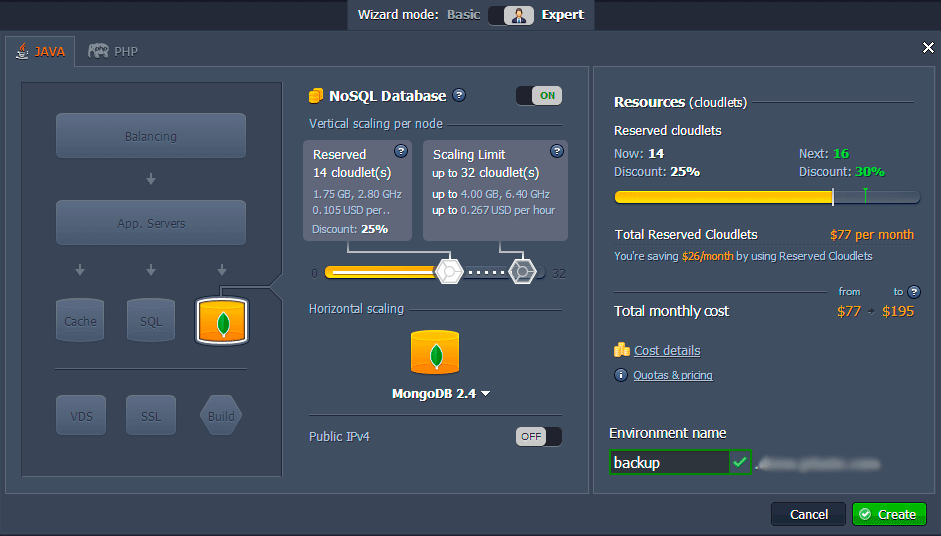
In a few minutes, your environment will appear on the dashboard.
3. Open MongoDB in a web browser, login into the RockMongo admin panel using the credentials, which BitssCloud has sent you while creating the environment, and then create your new database.
Configure MongoDB backup
1. Click the Config button for the database for further MongoDB backup configuration.
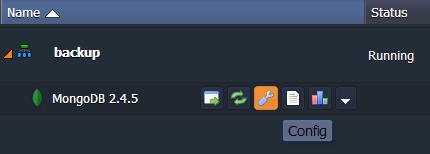
2. Move to the scripts directory and navigate to the backup_script.sh file. Find the next string and set your values:
MONGO_USERNAME="admin"; MONGO_PASSWORD="<your MongoDB password>"; DAYS_TO_STORE=3;
In this case <MONGO_USERNAME> and <MONGO_PASSWORD> are your database credentials which you should have received via email while creating the BitssCloud environment.
<DAYS_TO_STORE> is the time period for storing the backup files (the default value is 3).
Don’t forget to save the changes!
3. Go to the cron directory and open the mongod file. Uncomment the next string to backup your database once per day (at night) due to default configurations:
@daily /bin/bash /var/lib/jelastic/bin/backup_script.sh

4. In the case that you want to backup, your database with another frequency, configure how often the script should run by adding the cron settings instead of the default value (@daily).
For example, if you want to backup your database every ten minutes, the string will look like the following:
*/10 * * * * /bin/bash /var/lib/jelastic/bin/backup_script.sh

5. Navigate to the scripts directory and specify the next configuration in the backup_script.sh file to backup specific databases or tables:
- to configure multiple database backups:
-d {db_name}
$MONGODUMP -u $MONGO_USERNAME -p $MONGO_PASSWORD -d DB_NAME1, DB_NAME2 >> $BACKUP_LOG 2>&1;- to configure database tables backup:
-t {table_name}
$MONGODUMP -u $MONGO_USERNAME -p $MONGO_PASSWORD -d DB_NAME1 -t TABLE_NAME1, TABLE_NAME2 >> $BACKUP_LOG 2>&1;
Note: You can use multiple values for databases and tables separated by commas. You have to specify the name of the database where these tables are placed to set the database tables backup.
Check MongoDB backup
1. Wait until the time that you scheduled the MongoDB backup.
2. Go to the Configuration tab and navigate the backup directory (/var/lib/jelastic/backup). You’ll find .tgz files with all executed backups there.
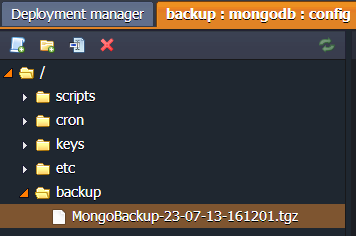
Download backup
1. Install FTP for your database server as it’s described in our “FTP/FTPS support in BitssCloud” guide.
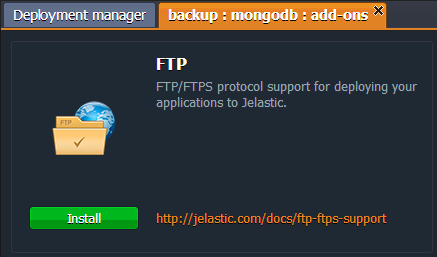
2. Connect to the MongoDB database using any FTP client (e.g. FileZilla) and download your backup files.
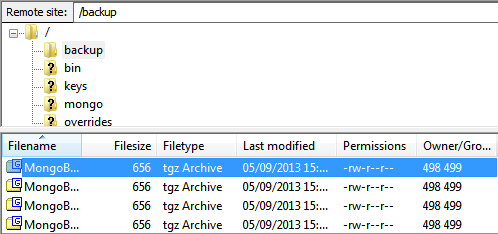
Restore files from a backup
1. Unzip the backup package you’ve downloaded earlier and navigate to the folder named as the database or the collection you want to restore. Then find the collection bson file in there.
2. Convert the bson file into json format using the next command:
bsondump my.bson > my.json
Note: You need to have MongoDB installed on your local machine. Locate your bson file in the mongodb…/bin folder and run the above command under this directory. The generated json file will be stored in the same folder.
3. Open MongoDB in a web browser and navigate to the database where you want to restore your data or create a new one.
4. Import your json file to the collection where you would like to have it located. And that’s all! Your data has been successfully restored.
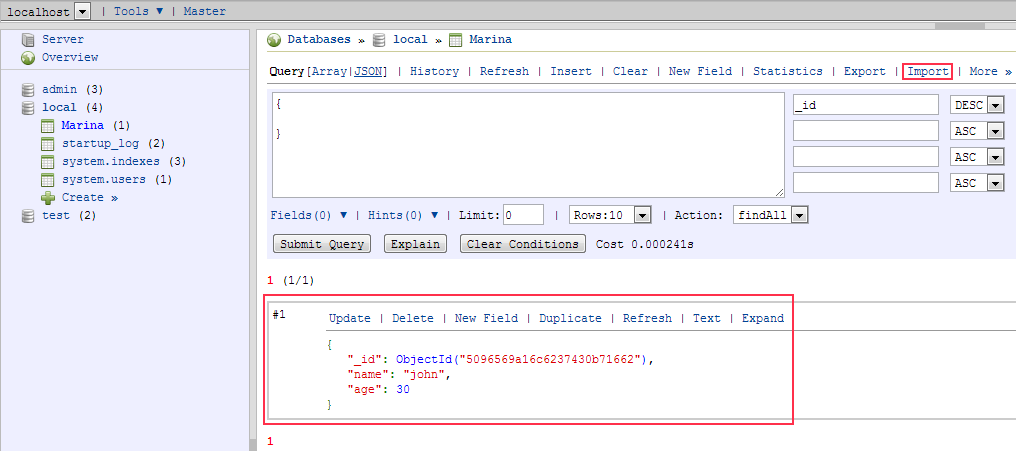
As you can see, it’s quite easy to get your MongoDB backup files in the Cloud. Now, all of your data is safe and you can restore and reuse it whenever you need. Enjoy!
